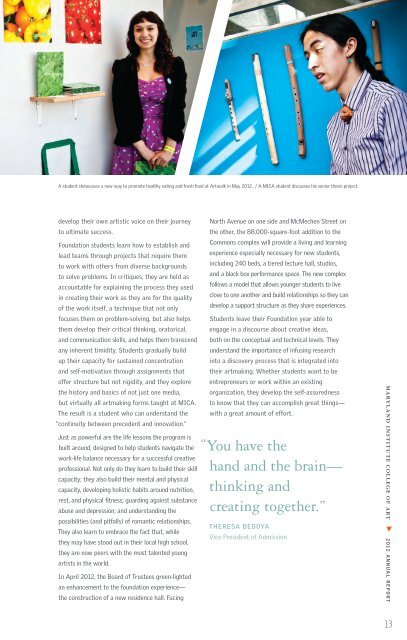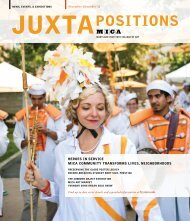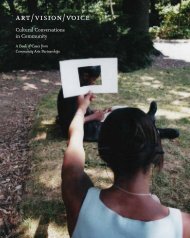They make a way. - Maryland Institute College of Art
They make a way. - Maryland Institute College of Art
They make a way. - Maryland Institute College of Art
Create successful ePaper yourself
Turn your PDF publications into a flip-book with our unique Google optimized e-Paper software.
A student showcases a new <strong>way</strong> to promote healthy eating and fresh food at <strong>Art</strong>walk in May 2012. / A MICA student discusses his senior thesis project.<br />
develop their own artistic voice on their journey<br />
to ultimate success.<br />
Foundation students learn how to establish and<br />
lead teams through projects that require them<br />
to work with others from diverse backgrounds<br />
to solve problems. In critiques, they are held as<br />
accountable for explaining the process they used<br />
in creating their work as they are for the quality<br />
<strong>of</strong> the work itself, a technique that not only<br />
focuses them on problem-solving, but also helps<br />
them develop their critical thinking, oratorical,<br />
and communication skills, and helps them transcend<br />
any inherent timidity. Students gradually build<br />
up their capacity for sustained concentration<br />
and self-motivation through assignments that<br />
<strong>of</strong>fer structure but not rigidity, and they explore<br />
the history and basics <strong>of</strong> not just one media,<br />
but virtually all artmaking forms taught at MICA.<br />
The result is a student who can understand the<br />
“continuity between precedent and innovation.”<br />
Just as powerful are the life lessons the program is<br />
built around, designed to help students navigate the<br />
work-life balance necessary for a successful creative<br />
pr<strong>of</strong>essional. Not only do they learn to build their skill<br />
capacity; they also build their mental and physical<br />
capacity, developing holistic habits around nutrition,<br />
rest, and physical fitness; guarding against substance<br />
abuse and depression; and understanding the<br />
possibilities (and pitfalls) <strong>of</strong> romantic relationships.<br />
<strong>They</strong> also learn to embrace the fact that, while<br />
they may have stood out in their local high school,<br />
they are now peers with the most talented young<br />
artists in the world.<br />
In April 2012, the Board <strong>of</strong> Trustees green-lighted<br />
an enhancement to the foundation experience—<br />
the construction <strong>of</strong> a new residence hall. Facing<br />
North Avenue on one side and McMechen Street on<br />
the other, the 88,000-square-foot addition to the<br />
Commons complex will provide a living and learning<br />
experience especially necessary for new students,<br />
including 240 beds, a tiered lecture hall, studios,<br />
and a black box performance space. The new complex<br />
follows a model that allows younger students to live<br />
close to one another and build relationships so they can<br />
develop a support structure as they share experiences.<br />
Students leave their Foundation year able to<br />
engage in a discourse about creative ideas,<br />
both on the conceptual and technical levels. <strong>They</strong><br />
understand the importance <strong>of</strong> infusing research<br />
into a discovery process that is integrated into<br />
their artmaking. Whether students want to be<br />
entrepreneurs or work within an existing<br />
organization, they develop the self-assuredness<br />
to know that they can accomplish great things—<br />
with a great amount <strong>of</strong> effort.<br />
You have the<br />
hand and the brain—<br />
thinking and<br />
creating together.”<br />
THERESA BEDOYA<br />
Vice President <strong>of</strong> Admission<br />
MARYLAND INSTITUTE COLLEGE OF ART 2012 ANNUAL REPORT<br />
13
















